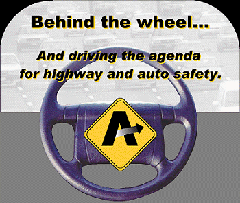![]()

NEWS
ROOM
ITD
News
USDOT News
Associated Press
News
Link
TRANSPORTATION
ORGANIZATIONS
State
of Idaho
ITD Home Page
AAMVA
AASHTO
USDOT
Federal Highways
TRIP
TRB
NTSB
NHTSA
EMPLOYEE
RESOURCES
PERSI
Group Insurance
Regence BlueShield
EAP
Idaho DHR
FINANCIAL
RESOURCES
IDAHY
Credit Union
Pocahy
Credit Union
|
National study rates states on traffic safety laws A recent report that analyzes efforts states make to ensure safety on the highways suggests Idaho has room for improvement.
“Our top concern is for the safety of people traveling on Idaho’s highways,” said Lance Johnson, ITD Office of Highway Safety. “We’ve been working with lawmakers to strengthen the seat belt law, and we’re making strides toward improving safety on our roads.” Johnson cites a 9 percent increase in seat belt use in 2003, and a 13 percent decrease in alcohol-related deaths, as reported by the National Highway Traffic Safety Administration. “Even with these accomplishments, this report is a serious reminder that we still have work to do,” Johnson said. While the report found no state has all 16 laws in place, some are in the “passing lane.” States such as California, North Carolina and Washington have most of the identified 16 laws, plus a primary enforcement seat belt law. There are more states “stopped on the shoulder,” such as Alaska, Minnesota, Mississippi, Ohio, Rhode Island and Wyoming, because they have the weakest adult occupant protection laws and have big gaps in their drunk driving, teen driving and child passenger safety laws. Most states, however, are crowded in the “slow lane” because they lack most of the 16 life-saving traffic laws. While numerous life-saving laws have been passed by states over the years, “unfortunately, there is still a vast, unfinished public health and safety agenda, including enactment of primary enforcement seat belt, impaired driving, all-rider motorcycle helmet use, booster seat and teen driving laws,” said Judith Lee Stone, president of Advocates for Highway and Auto Safety. “Without these laws being uniformly applied as a foundation for an aggressive traffic enforcement program, states will struggle to reverse the rising tide of highway deaths and injuries.” The report found variations in state traffic safety laws across the nation. For example:
“In contrast, every person flying on every airplane, in every state, is subject to the same uniform safety laws and regulations set by the federal government,” said Jacqueline Gillan, vice president of the advocacy group. “This uniformity has been the foundation for achieving an exemplary aviation safety record in the U.S. Were this the case for motor vehicle travel, and nearly every state had the same essential traffic safety laws, thousands of deaths and millions of injuries could be prevented. This report shows that we are a long way from achieving this goal.” The report divides 16 model laws into four issue categories. In each category, states are listed alphabetically in one of three sections: Good, Average and Poor. The four sections and corresponding laws are:
Motor vehicle crashes are the leading cause of death for Americans ages 2 to 33. During 2002 in Idaho, 264 people were killed and 14,762 were injured in traffic crashes. Nationwide, 6.3 million crashes resulted in 42,815 deaths and 3 million injuries. Highway crashes cost taxpayers and the economy $230 billion annually, according to the National Highway Traffic Safety Administration (NHTSA). Advocates for Highway and Auto Safety is a group of insurance companies and consumer, health, safety and law enforcement organizations that work together to advance state and national highway and vehicle safety policy. For a full copy of the report, visit www.saferoads.org |
||||||||
|
Return to Transporter Main Page
|
 The
report is called “Roadmap to State Highway Safety Laws:
A Report on States in the Passing Lane, in the Slow Lane and
Stopped on the Shoulder.” It details where the 50 states
and the District of Columbia "pass or fail" on 16
proven-effective highway safety laws in four categories: adult
occupant protection, child passenger safety, teen driving
and impaired driving. It was released by Advocates for Highway
and Auto Safety earlier this month.
The
report is called “Roadmap to State Highway Safety Laws:
A Report on States in the Passing Lane, in the Slow Lane and
Stopped on the Shoulder.” It details where the 50 states
and the District of Columbia "pass or fail" on 16
proven-effective highway safety laws in four categories: adult
occupant protection, child passenger safety, teen driving
and impaired driving. It was released by Advocates for Highway
and Auto Safety earlier this month.
